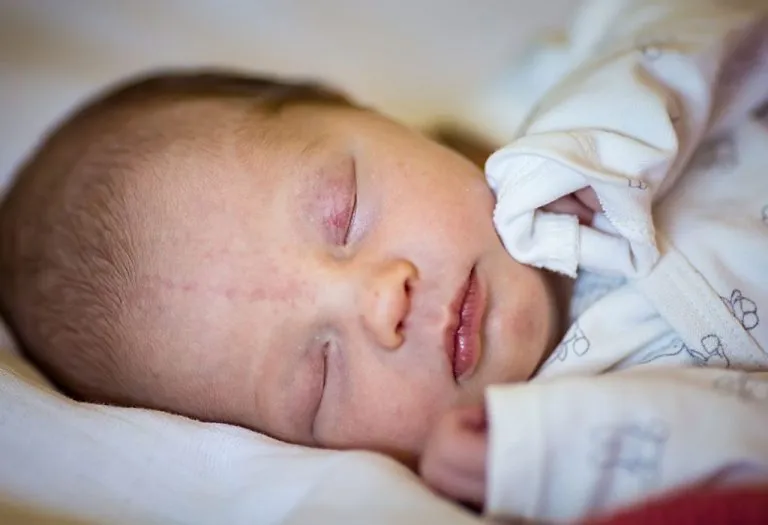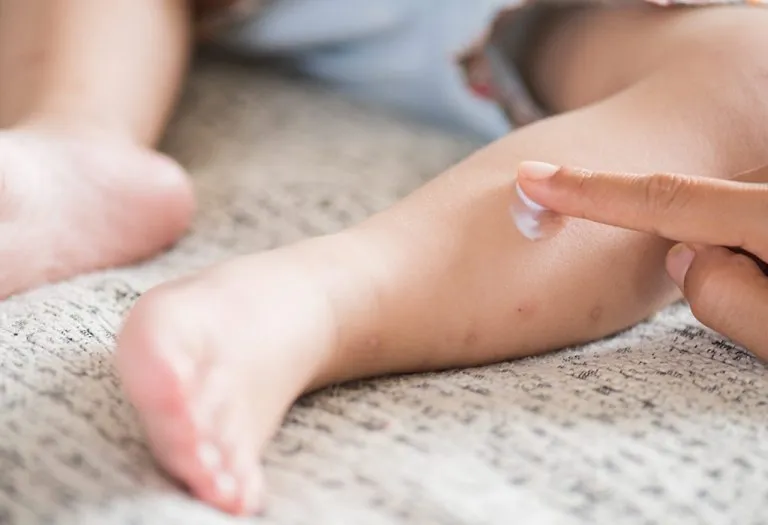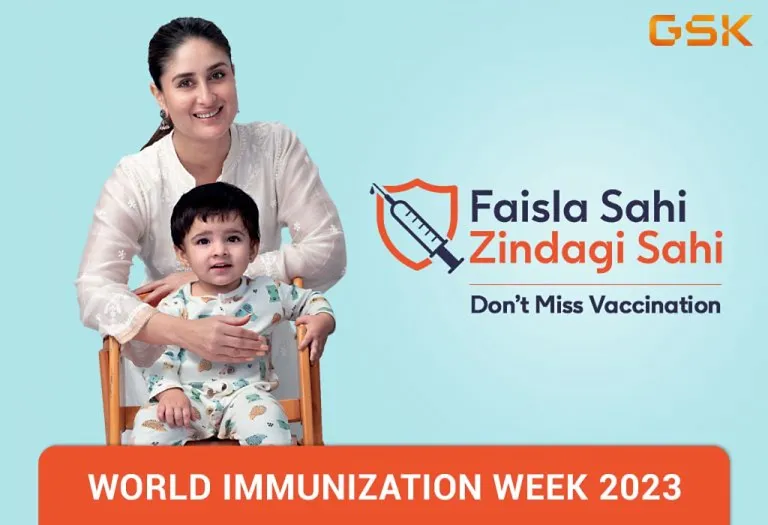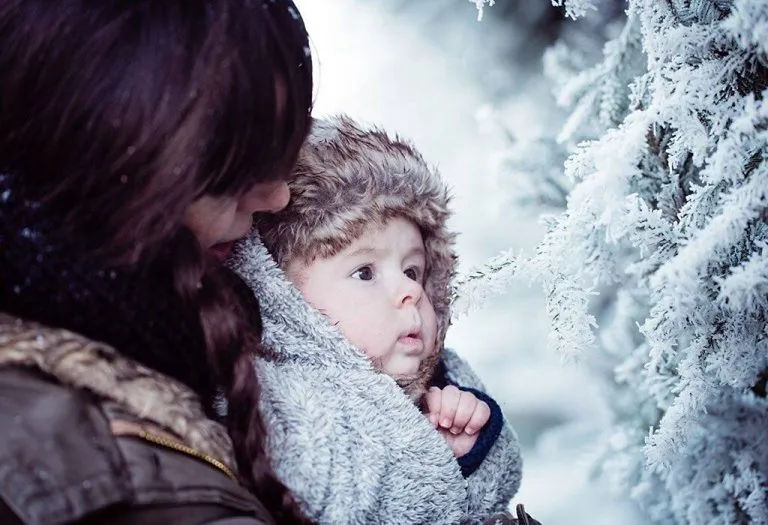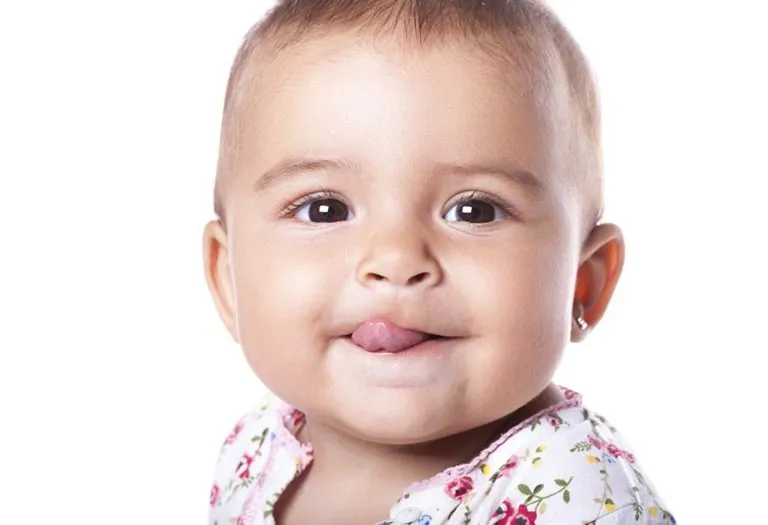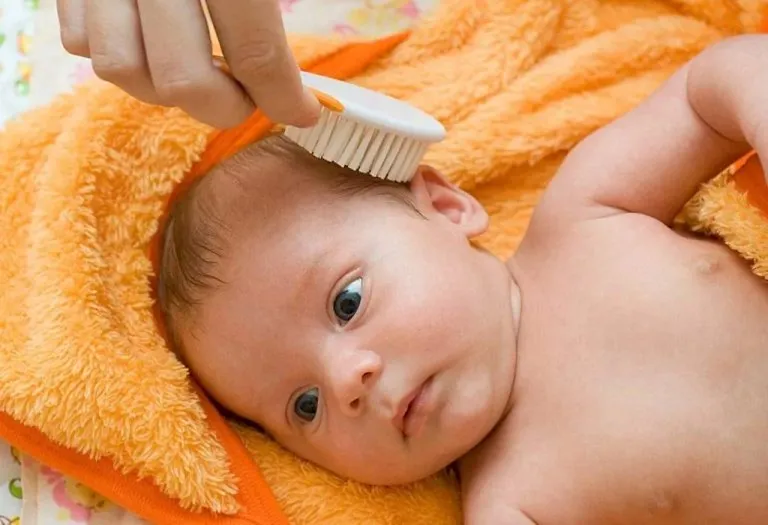Salmon Patch (Stork Bites or Angel Kisses) Birthmarks in Newborn Baby
Some newborn babies are born with birthmarks on their skin, which are also known as salmon patches because of their pinkish or reddish tinge. These marks are typically harmless and occur in a large number of infants. Parents may worry about these patches on their babies’ skin; however, they are common and may fade after some time without any medical intervention. If you are intrigued to know more on this topic, then you should read the following article where we share various aspects related to salmon patches in newborns, including their causes, appearance, and when to seek medical advice. Let’s begin with understanding what a salmon patch is.
What Is a Salmon Patch?
Salmon patches are dilated blood vessels or capillaries on a newborn baby’s skin. They are also called Nevus Simplex, but in simpler language, they are identified as birthmarks. These flat pink or red patches do not have any defined borders and may appear on both dark and fair skin babies. When a salmon patch appears on the face, it is referred to as ‘angel kiss’, and when it is present on the back of the neck, it is called ‘stork bite’.
Where Are Salmon Patches Found?
Salmon patches are flat, pinkish or reddish patches that can be found between the eyebrows, over the eyelids, around the mouth, on the nose, or on the nape of the neck.
Who Gets Salmon Patches?
All babies have salmon patches before they are born. However, only 70 per cent of the babies may have salmon patches after birth. Though most of these patches disappear within one to two years after birth, some may remain on your baby’s skin even after that.
Are They Infectious?
No, salmon patches are not infectious. These patches appear due to the dilated capillaries on the baby’s skin and not because of a viral or bacterial infection.
Difference Between Stork Bites and Angel Kisses
Angel kisses and stork bites are both salmon patches, but they mainly have two differences. The first difference is in their location – angel kisses appear on the front side, for example, around the mouth or on the nose; while stork bites appear on the backside, i.e. on the nape of the neck. Another point that differentiates stork bites and angel kisses is the timeline they take to fade away. Angel kisses disappear faster than the stork bites. In some cases, stork bites on newborns may not disappear and stay on the baby’s skin forever.
How Long Do These Patches Last?
Angel kisses usually do not last very long and disappear after some time, in most cases within a year. However, stork bites most likely remain in approximately 50 percent of the cases.
Can Salmon Patches Be Prevented?
As mentioned earlier, salmon patches are common in babies. There is not enough scientific evidence to prove why they occur in babies. Therefore, If you are looking for ways to prevent these patches, there not much you can do. The patches will appear and either fade away or remain.
What Are the Causes of Salmon Patches?
It is extremely normal for parents to question what causes stork bites or angel kisses in babies. Parents will also want to know if there is anything that can be done to prevent these patches. The thing is, there is a possibility that birthmarks are inherited. But, as far as causes are concerned, no known cause can establish why salmon patches occur on a baby’s skin.
The stretched blood vessels under the skin may become more pronounced when your baby cries, is upset, or when the room temperature changes. However, it is important for parents to understand that salmon patches are extremely harmless and benign. They will gradually disappear and may not affect the baby’s growth and development.
If you’re thinking how you could identify salmon patches, look for the symptoms given below.
Symptoms of Salmon Patches
Salmon patches can be easily identified by their appearance. Here are some of the symptoms of salmon patch rash or salmon patch:
- They are visible on the face or on the nape of the neck.
- They have a pinkish or reddish tinge.
- They are flat marks on the skin.
- These patches do not have defined borders.
- These patches do not cause any kind of itchiness or pain.
- They may become more noticeable when the baby cries or when there is a change in temperature.
Diagnosis of Salmon Patches
It is suggested that as soon as you notice any mark on your baby’s skin, you should get in checked by your doctor to know whether or not it is harmful to your baby. Refrain from any kind of self-diagnosis and assumptions regarding the marks on your baby’s skin.
Your doctor can easily identify a salmon patch by merely looking at it. However, apart from the appearance, the location of the mark also helps your doctor in making a correct diagnosis. There may not be a requirement for a test or biopsy to confirm the diagnosis unless your doctor feels otherwise.
Home Remedies for Salmon Patches in Babies
Salmon patches in babies are generally harmless and fade on their own over time. However, parents can try some of these simple home remedies to care for their baby’s delicate skin and promote overall skin health.
1. Cold Compress
A cold compress can provide a soothing effect on the skin and may help lighten the appearance of salmon patches. To use this remedy, wrap a few ice cubes in a soft towel or washcloth and gently place it on the affected area for a few minutes. Be sure never to place ice directly on your baby’s skin, as it can cause discomfort or irritation. This remedy can be done two to three times a day.
2. Olive Oil
Olive oil is a natural moisturizer that deeply nourishes the skin and may help reduce the visibility of salmon patches. To use it, massage a few drops of olive oil onto the patches in a circular motion for about five minutes. Afterwards, rinse the area with warm water. This process can be repeated up to four times daily to maintain hydrated skin and potentially lighten the patches.
3. Vitamin E
Vitamin E is widely recognized for its powerful antioxidant properties, which can help repair damaged skin and reduce birthmarks. Aloe vera, a rich source of vitamin E, can be applied directly to the patches. Use a small amount of pure aloe vera gel and gently massage it into the skin twice a day. Regular use may improve the skin’s appearance over time.
4. Lemon Juice
Lemon juice is a natural bleaching agent that can help lighten dark patches on the skin. To apply, dilute a few drops of lemon juice with water and use a cotton ball to gently dab the solution onto the salmon patches. After a few minutes, rinse the area with warm water. This remedy is best used once a day to avoid over-irritation, as lemon juice can be strong on sensitive skin.
Treatment of Salmon Patches
There is no requirement of any kind of treatment for a salmon patch. It is recommended that you wait for the patch to disappear on its own, which is usually a year or two after your baby’s birth. Angel kisses or stork marks are extremely harmless and do not cause any kind of medical complications in babies. However, if the birthmark is present after a few years, you may consider salmon patch birthmark removal by laser. If you do not want to go in for laser surgery, then make-up can be used to cover the angel kisses whereas stork marks usually get covered by hair.
When to See a Doctor
Birthmarks are harmless, and the birthmark skin behaves like normal skin only. If your doctor has confirmed that the mark on your baby’s skin is a salmon patch, then there is no need to worry. However, if you notice any change in your baby’s birthmark, then you need to act immediately. If you notice swelling, bleeding, or any other unusual symptom on or around your baby’s birthmark, you should seek immediate medical help.
FAQs
1. Can salmon patches reappear after they have faded?
No, salmon patches typically do not reappear once they have faded. These birthmarks usually fade as the baby grows, often disappearing entirely by early childhood. If new patches appear, consult a pediatrician to rule out other conditions.
2. Are salmon patches linked to any genetic factors?
Salmon patches are not considered to be directly linked to genetic factors. They are common vascular birthmarks caused by dilated blood vessels near the skin’s surface and occur in a significant number of newborns without any hereditary connection.
3. Can salmon patches affect a baby’s vision or health if they are on the face?
In most cases, salmon patches on the face do not affect a baby’s vision or overall health. However, if a mark is unusually large, raised, or located near the eyes, it is advisable to seek medical advice to ensure there are no underlying issues.
A mark on your baby’s body may invoke concern in parents, and it is very normal to feel so. However, it is also true that most angel kisses and infant stork bites are temporary and may soon disappear. If you have any concerns about salmon patches on your baby’s skin, you should get in touch with your doctor.
References/Resources:
1. Vascular birthmarks; Harvard Health Publishing; https://www.health.harvard.edu/a_to_z/vascular-birthmarks-a-to-z
2. Birthmarks in Infants; Johns Hopkins Medicine; https://www.hopkinsmedicine.org/health/conditions-and-diseases/birthmarks-in-infants
3. Birthmarks; NHS; https://www.nhs.uk/conditions/birthmarks/
4. Stork Bites; Vascular Birthmark Institute; https://www.vbiny.org/blog/stork-bites/
5. Birthmarks; Seattle Children’s Hospital; https://www.seattlechildrens.org/conditions/birthmarks/
6. Stork Bite; Cleveland Clinic; https://my.clevelandclinic.org/health/diseases/21975-stork-bite
7. Stork bite; Mount Sinai; https://www.mountsinai.org/health-library/diseases-conditions/stork-bite
Also Read:
Skin Allergies in Newborn
Mongolian Spots in Newborn Baby
Home Remedies for Heat Rash in Infants
Treating and Preventing Neck Rash in Babies
White Patches or Spots on Child’s Face
Was This Article Helpful?
Parenting is a huge responsibility, for you as a caregiver, but also for us as a parenting content platform. We understand that and take our responsibility of creating credible content seriously. FirstCry Parenting articles are written and published only after extensive research using factually sound references to deliver quality content that is accurate, validated by experts, and completely reliable. To understand how we go about creating content that is credible, read our editorial policy here.





